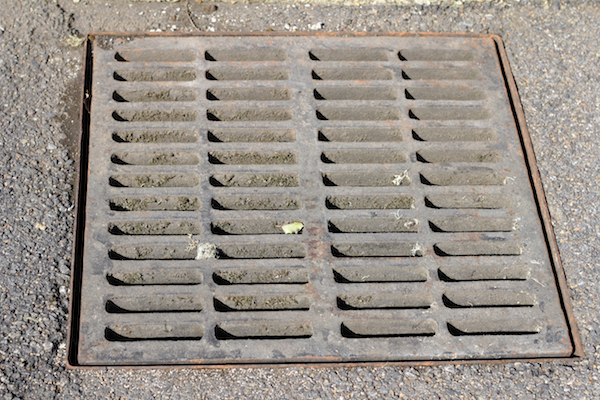Repairing catch basins can be an important part of keeping your parking lot in good condition and can save on costly repairs further down the road. Catch basins are an integral part of a parking lot. They help drain water runoff and prevent pooling water that can damage asphalt. For large asphalt surfaces, having catch basins are essential for preventing damage, and necessitating costly repairs.
However, catch basins fail for a variety of reasons. When one becomes damaged or stops draining properly, speedy repair can be the difference between keeping a parking lot in good condition or incurring a large expense for repairs.
One issue that causes failure is that the drains become clogged with debris, preventing proper drainage and leading to a backflow of water. The grates are spaced to prevent large objects from entering, but smaller debris can still flow through the grate and into the drains. Leaves, twigs, dirt, small branches and litter can all contribute to clogging.
When the drain pipes get blocked, the water is allowed to overflow onto the pavement or penetrate beneath the edges of the pavement surrounding the catch basin. Water penetration can erode the pavement’s foundation, often leading to alligator cracking or severe potholes.
If the trapped water freezes, the expanding ice can damage the mortar around the catch basin’s frame. This can allow the grill and frame to move out of position or lead to the creation of a sinkhole.
A catch basin can fail due to damage. Over time, the blocks and bricks used to construct the catch basin can erode and deteriorate. Also, water can begin to infiltrate the catch basin casing or pool in-between the grate and asphalt. Eventually, when deterioration has happened, the catch basin can sink, collapse or simply stop working.
On all large properties, including condominiums, shopping plazas, or even at a football stadium, catch basins help alleviate flooding from a rainstorm. It’s not until warning signs are noticed that fixing the catch basin becomes a priority.
Symptoms can range from seemingly harmless water slowly trickling into drain gutters to massive sinkholes that cause serious damage to roads and properties. Standing water after a 5-inch rain shower and even sinking pavement are indicators that the catch basin may not be working properly.
Typically, asphalt removal and replacement will be performed on the area surrounding the catch basin, removing any damaged asphalt and ensuring access to the grate and frame of the catch basin. Depending on the extent of the damage, different repairs will be performed. For minor damage, a contractor may be able to simply replace bricks and blocks. However, if there has been a collapse or other severe form of damage, then they may need to perform catch basin rebuilding, reconstructing much of the catch basin.
The type of procedure that you will need to restore your catch basins to functionality depends on the cause of your problem.
- If the problem is slow drainage, there may just be a clog. A thorough cleaning may be all that is required.
- Small cracks, broken pavement or broken grills can normally be repaired quickly and economically.
- If the catch basin has sunken or collapsed, it may need to be completely rebuilt.
- Serious damage to the surrounding pavement may require the removal and replacement of the affected pavement. If the damage is extensive, resurfacing or repaving are options to explore.
- Milling may be a solution if the problem is related to the slope of the pavement.
If repairs are needed, it is important to have them performed as soon as possible. The damage to your pavement will continue to worsen, resulting in more expensive repairs and greater disruption to your traffic. Regular inspections of your parking lot’s catch basins can help you identify problems as soon as they develop.

